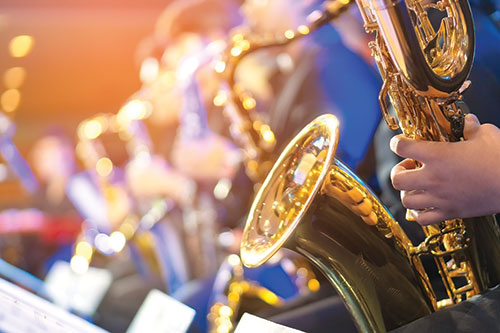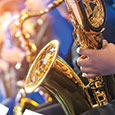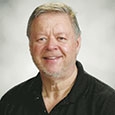For many students, jazz band is one of the most enriching parts of their musical lives. Never let a lack of time, equipment, or teaching experience stop you from starting a jazz program. Jazz band can hook students on music, and it is an excellent vehicle for marketing your program. A jazz band can more easily perform at community centers or school meetings, and this exposure increases the profile and value of the band program in the community. Here are tips on recruiting, structure, literature, rehearsing, style, and basic improvisation.

Recruiting
You might have to convince a few talented students that they have the time for jazz band and will provide leadership. My best sales pitch is to ask students to come to a rehearsal and come back if they like it. If after a few rehearsals they do not enjoy it, they need only let me know. Although concert band is mandatory for jazz band students who play horns and percussion, jazz band participation is voluntary.
We recruit bass players from the orchestra and piano players from the band. If you don’t have an orchestra or a bass guitar player, you can recruit multiple piano players and have them alternate between piano and playing the bass guitar part on keyboard with sound modules that closely resemble an upright bass. I have even taught tuba players to transpose bass parts and teach them the connectivity and note decay of a walking bass line. You can also find pianists and guitar players from outside the music program, but such students might used to playing alone and struggle with ensemble rehearsing and performing.
Until your jazz band grows, you might have to include non-traditional instruments. Clarinets, euphoniums, and even tuba players supporting the bass part are common substitutions, as players of these instruments can use existing parts. Consider having more than one alto sax player on a part, so the parts will be heard and if someone is absent the part is covered. You can also rotate players if you have the numbers.
Equipment
A drumset should include a ride, hi-hat, and crash cymbal; a shallow snare drum (some players even use a piccolo snare); a mounted tom; a floor tom; and a bass drum. There should also be a throne with the set; drummers cannot use their feet effectively on a chair. If a drumset is not in the budget, divide the drumset part for multiple students to cover. For added luxury, purchase a rolling drumset cart.
Ideally, you should have two keyboards – one for the piano part and one for the bass part if you do not have a bass player. We frequently use both a bass player and a bass keyboard for sound reinforcement. A keyboard with sound sampling is ideal for replicating such sounds as upright bass, bass guitar, and Hammond organ.
Set-Up
The bass and drumset should be in line with the trombone row, and the piano/keyboard and guitar player should be in line with the saxophone row.
Pianists usually play with their backs to the audience so the piano lid can be opened an projecting the sound toward the band. Electronic keyboards do not have lids that need to be opened, so keyboard players should face the sax row.
Amplifiers for bass (and keyboard if applicable) should face diagonally across the band so both the band and the audience can hear it. For clarity, bass levels should have the treble turned up all the way and the bass turned down all the way. Too much bass level makes the bass line sound muffled.
The lead trumpet, trombone, and alto sax players should sit as close to the center of the horns as possible. Typically the first tenor, second trombone, and second trumpet are the closest to the rhythm section, with the three lead players next. In addition, the lead players should be louder that the other parts in their section; this is especially true for alto sax. The other horn players should follow the lead players for both balance and style.
Literature
You will garner more interest in the jazz band by programming mostly rock-based songs at first. Students will understand rock long before they will be able to grasp bebop. Get students playing aggressively and confidently on a concert of mostly rock tunes with a few swing tunes, then gradually introduce Latin, bossa nova, and ballads. By seventh grade our jazz band only plays one rock chart per concert, with the rest of the program consisting of more traditional jazz styles.
I always find a few easy arrangements of something contemporary. Our sixth grade jazz band, which runs from March-May, only learns two songs. For seventh and eighth graders, choose quantity and variety over learning a few difficult pieces. I want the students to experience swing, rock, Latin, ballads, funk, fusion, and anything else I can find. For each piece I pass out, I ask the students to search the internet and find several performances of that piece that they can share with everyone at the next rehearsal. Nothing is more important in a young jazz player’s musical progression than listening, and this is a great way to get them started on it.
The collections below are good sources of starting jazz literature, with the last two being more advanced. Most of them have already written parts for flute/vibraphone, clarinet, horn, treble clef euphonium, and tuba.
• First Year Charts Collection for Jazz Ensemble (Belwin).
• Standard of Excellence Jazz Ensemble Method (Kjos).
• The Best of Essential Elements for Jazz Ensemble (Hal Leonard).
• Discovery Jazz Collection (Hal Leonard).
• Easy Jazz Classics (Hal Leonard).
• Easy Jazz Favorites (Hal Leonard).
I recommend against using all of the wind parts included in a jazz tune at first, especially for brass sections. Inexperienced players can struggle with rich jazz harmonies, and you might lose rehearsal time figuring out which trombone part of four is missing a partial. In beginning jazz band we only use two parts each for trumpet and trombone, leaving the other parts uncovered. For seventh- and eighth-grade jazz bands, I suggest using no more than three of the provided parts for trumpet and trombone so these sections do not lose power. In many charts, the fourth part is written with tricky jumps and harmonies doubled elsewhere. Most of the literature suggestions above sound fine with parts left out.
Jazz Styles
Rock. Students, especially drummers, already know this style and will be the most comfortable with this type of music. The horns get to play loud with a bass and drumset going underneath. Students will feel like they are playing in a band that they would hear on television.
Latin. Most of the heavy lifting in this style happens in the rhythm section. For the horns, a Latin chart is all about the strength of articulation, especially at the fronts of notes.
Jazz ballad. This style is closest to the traditional band playing, (called “playing straight”) but the harmonies are usually thick, and ninth chords are common.
Swing. This style is also called shuffle. To teach swung eighth notes, I first refer to the Scooby-Doo cartoon, because the dog’s name is a good introduction. Scooby-Doo eventually transitions to doo-be doo, which is a gateway to more traditional scat singing. My favorite album for listening to swing style is The Complete Atomic Basie, and when students enter the band hall for jazz rehearsal, either this album or anything by Tower of Power will be playing.
Performance Practices
Staccato. I teach the syllable dit as an example of how staccato should sound in jazz. Stop with the tongue, not the throat. Latin charts especially require the crispness of a tongue stop. Students should be taught such articulations early but must be monitored to make sure they do not use them in concert band. If I catch students using tongue stops in concert band, they are not allowed back in jazz band until they can demonstrate that they understand when to use them. The only song that has ever caused students to fall into the habit of using tongue stops in concert band was Tequila, which I have never again used in beginning jazz band.
Legato/tenuto. This is no different in jazz than it would be in concert band, although students might not realize that each legato note should connect to the next, even if there is no slur. In swing style, every note is considered legato unless it is marked otherwise or unless it is the last note in a string of swung eighth notes, in which case it should be treated as if it was marked staccato and performed with a tongue stop.
Accents and fortepianos. The > accent is the same as in concert band, with the strength at the beginning of the accented note. However, a marcato accent (^) is different. Rather than the note being accented and staccato, it should be played fat with a tongue stop. I use the syllable daught to teach this accent. In swing style, there should also be a slight emphasis on the offbeat, especially if this note is a higher pitch. Students new to jazz often overdo this. Also in swing style, if an eighth note at the end of a measure is tied to a long note in the next measure, this should be performed as a fortepiano with a crescendo.
Vibrato. Unlike classical vibrato, which starts immediately upon playing a note, a jazz vibrato does not start until after the note has been established for a beat or two. Trombonists should use jazz slide vibrato when playing jazz ballads.
One of my favorite resources for learning and practicing common jazz rhythms, articulations, and style is Essential Rhythms for Jazz Ensemble by Doug Beach & George Shutack (Kendor). It is perfect for second-year jazz students, although it will likely be too much for first-year players. It has four different sections: Swing, Latin, Bossa Nova, and Rock and has 23 short common jazz riffs grouped in four-measure phrases. The swing etude is useful for an onstage warmup – perfect for checking the balance between the rhythm section and horns.
Improvisation
Teaching improvisation is the most likely cause of hesitancy to start a jazz band in directors without jazz experience. As a tuba player, the only time I ever improvised was when the wind blew my music off the stand, but jazz is a language that can be learned.
In February of each year, my beginning concert band students spent two to three days learning to improvise from the Bb blues scale. I tell beginners that improvisation is similar to your math teacher handing out a test and saying, “As long as you try to answer the problems rather than give up, you will pass.” The activity got students out of their comfort zone and gave them early experience improvising, which is especially beneficial for the students who thrive on structure. Perfectionists seem to struggle more with improvisation, and many times my best improvisers were in the second jazz band, because they were more at ease thinking out of the box.
When we teach improvising we start with call-and-response exercises, in which students mimic the rhythm and style of the director. We use the Blues in the Key of Bb Concert audio track from Jamey Aebersold’s How to Play Jazz and Improvise (Volume 1) (Jamey Aebersold Jazz). Although we are in Bb, I have students start on concert F, which is in a more comfortable part of everyone’s range. Call and response works best with a quarter rest on the last beat of each measure. I start with three quarter notes, varying between long (doo) and short (dit). The next step is to add one pair of swung eighth notes on beat two (such as doo doo-be doo; doo doo-be dit; or doo doo-dit doo), followed by eighth notes on beats one and two (such as doo-be doo-be doo; dit doo-be dit; or doo-be doo-dit doo).
After students are comfortable imitating you, move to two-measure calls, with students answering you on a different rhythm than what you played. I require students to stay on concert F until they can make up rhythms while staying on the beat, and the only other rule is to play loudly and confidently in time with the pulse without stopping. Many students will initially make it through one measure of improv and then stop, creating an uncomfortable four-beat pause. Keep encouraging them to fill up the full two measures. I like to go down the row without stopping; every two measures either you play or a student does. After every student plays their two measures – or any time they improvise – no matter how they did, have the other students applaud.
After students feel confident on concert F, have them use the first two notes of the Bb blues scale (Bb and Db). Moving from one note to three or more might cause a decline in confidence and rhythmic accuracy previously established on concert F. Use the same down-the-row exercise as above, where the teacher plays two bars, then a student plays something different for two bars. This can be expanded to playing for four measures at a time and adding Eb to the list of allowed notes, but this is as far as I go with beginning jazz players for months. Young improvisers tend to focus more on the fingers than on making a solo rhythmically interesting, so giving them limited tools is the most effective approach. The aim at this stage is building confidence.
I treated all solo sections in jazz charts as open solo sections. Some jazz pieces include a written solo for students who are unable to improvise from chord changes. I would choose a younger student to play first and give that student the written solo. Although the person with the written solo was not required to adhere strictly to what was written, it was available to use as long as they played loudly, in time, and without stopping.
The second time through the chorus I would give the written solo to an older student, who was allowed to use the pitches of the written solo but not in the same sequence or rhythm so it sounds different. One bit of advice that helps students is “If you play a note that sounds funny, move to a different note.”
I use written solos only for the first concert or two. After that, do not permit students to play the written solos. Have them come up with their own creative ideas. If a written solo is the only viable option, have the students memorize it.
***
The Bb Blues Scale
In the blues scale the notes in the parentheses are akin to passing tones. Improvisers should avoid sustaining them for any extended length of time.
C Instruments: Bb Db Eb (E) F Ab Bb
Bb Instruments: C Eb F (F#) G Bb C
Eb Instruments: G Bb C (C#) D F G
F Instruments: F Ab Bb (B) C Eb F
***
Rehearsal Frequency
Sixth grade jazz band only rehearses once a week before school starting after our Spring Break. The seventh and eighth grade students rehearse either before or after school twice per week the entire school year. For these older students it is important that they rehearse twice a week. With only one rehearsal a week, you will likely have to reteach the style and articulation at every meeting.
Conclusion
Jazz provides students with an opportunity to play what they might have seen musicians on television play, and it will make them feel like accomplished musicians while increasing student interest, reading ability, and confidence. Do not let a lack of experience keep you from teaching jazz.
F Instruments: F Ab Bb (B) C Eb F






